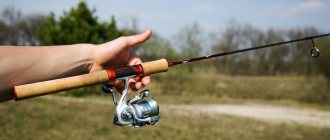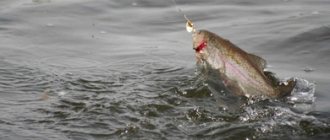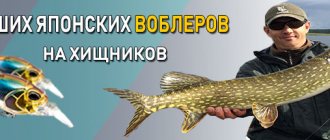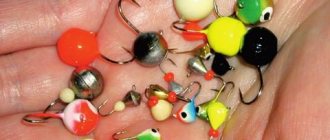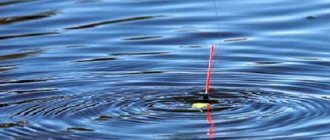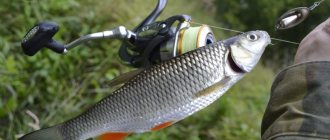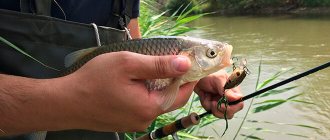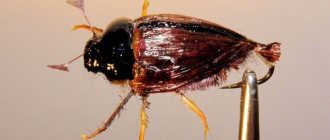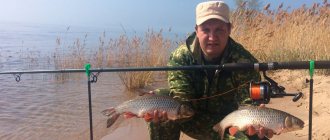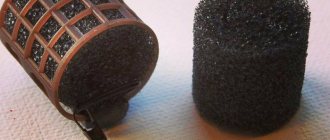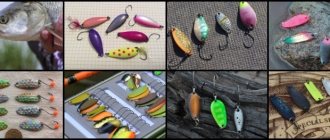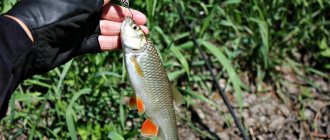Lucky Craft Bevy Minnow
The Japanese company Lucky Craft is known among spinning fishermen for its high-quality, well-designed baits. In terms of price and quality, this company can be placed somewhat higher than Jackall, whose products are widely distributed in our country.
Lucky Craft Bevy Minnow is a series of ultra-light minnow wobblers that imitate elongated fry. Available in two sizes: 3.8 and 4.5 cm. They come in a suspended version with neutral buoyancy. The 4.5 cm variation is also available in a floating version. These elegant wobblers weigh 2 g and are 3.8 cm long; 2.5 – 2.7 g for larger option. Despite their modest size and weight, Bevy Minnows fly well thanks to the built-in long-casting system. The decoys are equipped with a pair of tees.
Wobblers work with a dive of 0.3 - 0.6 m. This allows you to fish with them in small rivers, streams, and ponds. They have shown their effectiveness both in fast currents, which they hold excellently, and above the carpet of aquatic vegetation in lakes. They regularly lure out fish that are hiding behind rocks from a fast flow or hiding in thickets of grass.
The color palette is rich, about 30 coloring options. There are plenty to choose from. The durability of the coating is excellent.
The model plays on uniform wiring. Wiring with pauses and various twitching and twitching are often used. The behavior during light jerks is very beautiful. Artificial fry respond differently to jerks of different strengths and lengths. In the catch:
- trout
- perch
- chub
- asp
- pike
Mostly, of course, small individuals. But for sport fishing, this is an excellent tool.
Fly fishing is easy
They once told me this, but I didn’t believe it. After all, something you have never done cannot be simple! Fly fishing means you have to wave a cord over your head, build the loops correctly... Fly fishing is beautiful, but nothing more. And it’s useless to argue with this opinion... until you try it yourself. Here, you know, it’s like learning to ride a two-wheeled bicycle. Everyone drives, but they can’t explain it to a beginner child. He doesn't know what balance is or how to achieve it. And there is nothing to compare cycling with!
Teachers hold the bike, support it while moving... But as soon as the hand is released, everything goes to hell. The steering wheel is in the wrong direction, the center of gravity is to the side, and you don’t understand what’s happening. Same thing in fly fishing. As long as the instructor is nearby, everything seems clear. And as soon as you start doing something on your own, the loop is wide, the cord doesn’t fly, it falls down. So, if you want to understand what fly fishing is, go to a small river! Long casts, holding a long cord above your head and other tricks are not at all necessary.
On a small river, it is enough to flop the “fly” exactly over a log under water or let it float with the flow over the grass. You just need to unwind just enough cord to reach the opposite bank. And if you can’t get it, take a step forward! Well, perhaps one more rule: move slowly against the flow. Thanks to fly fishing for chub, I became interested in various casting techniques, moving the line upstream, “snakes”, loops, etc. Controlling a “torpedo”* is, you know, addictive. The main thrill of spinning is accurate casting; then everything depends on the work of the spinner or wobbler.
And in fly fishing, accurate casting is a matter of course. On a small river the line is already about to be completed - you still have to try. But to skillfully “plop”, beautifully and without delay allow a grasshopper (“grasshopper”) to swim along the border of algae - this is even more akin to hunting than fishing. That is, we get both. But I'm not calling for anything. If you don't know how to ride a bike, don't! I’m not a cyclist either... But wandering around in knee-deep water with fly fishing in the summer is, you know, an incomparable pleasure.
Currently I am using a Stinger Fly North Creeck 9064 #6 fly rod with a River Cross 3 #5/6 and Scientific Anglers Trout WF-7-F . I will not praise or scold my kit, because, I repeat once again, I am not a “cyclist”, however, I had 4 fly fishing “lisapets”, the first of which I managed to break on a kilogram chub.
He broke it, of course, out of stupidity, out of ignorance - in short, in Russian. In general, 6th grade is the most universal for my latitudes. I also sometimes catch saberfish and ides on Akhtuba. Well, on a small river, long-distance casting is most often not needed. Rewind as much as necessary - and make spey casts with all kinds of water and air “anchors”. And I like this simple fly fishing,
Lucky Craft Gengoal
Another original concept from Lucky Craft is the Gengoal wobbler. The appearance is unusual. This is an imitation of a swimming beetle. Recreating fish food that is familiar to them is always a strong move.
The wobbler is available in two sizes: 3.5 and 4.5 cm. Only the 3.5 version falls purely into the ultralight range. I will concentrate my attention on them. They are produced in floating and sinking versions, with weights of 3.5 and 4.8 g, respectively. A floating one can be driven to about 0.7 m, but a sinking one, depending on the length of the pause.
The Lucky Craft Gengoal is equipped in a somewhat unusual way: a pair of doubles. You can experiment and replace it with winding rings with tees. The main thing is to test that the size of the hooks is suitable and does not spoil the baby’s play.
Range is one of the main strengths of this decoy. Compactness and balance are excellent. So we have one of the longest-range baits in the ultralight class. This is actively used to deliver tackle further away, under the nose of sharp-eyed and suspicious fish.
Gengoal is produced in 16 colors. Most of them tend to imitate the shell of a bug, which is not surprising. The wobbler plays superbly and oscillates pleasantly on a smooth retrieve. This way it accurately recreates the behavior of its natural prototype.
I recommend these products for catching chub, trout, perch, ide, and large rudd.
Wobblers for ultralight Jackall Chubby
The Japanese company Jackall has gained wide popularity among spinning players. This is one of the best brands in terms of price and quality. There are a lot of really cool models. They are also available in the ultralight segment.
Jackall Chubby line of wobblers anything other than legendary. Chub is translated as chub, which clearly indicates the main prey of the blende. This is a thick “crank” or even “fat”. The younger brother of the larger Cherry roll.
The length of the Chabikov is 3.8 cm. Depending on the version, the weight varies in the range of 4 – 4.7 g. They fall into the ultralight range, on the verge.
Jackall Chubby is available in working depths:
- SSR (0 – 0.3 m)
- SR (0.5 – 1 m)
- D (1 – 1.5 m)
- DD (1.5 – 2 m)
All types are clearly floating. Thanks to its active and persistent play, the wobbler perfectly attracts chub and perch. There are small pike, roaches, and other predatory and semi-predatory fish.
Chabiks are presented in a very wide color palette. There are more than 30 options. So you can choose halftones.
Uniform wiring and various light jerks, plays along, and pauses are used. Wobblers of this series play very stably, including in fast, stormy currents.
The price of Jackall Chubby is in the conventional average range. There are many Japanese wobblers that are much more expensive. This is a worthy copy in the box of any light spinning player.
Lucky Craft Cra-Pea
Judging by the variety of design options, Lucky Craft Cra-Pea is the company’s flagship in the cran segment. About a dozen subspecies of bait fall under the parameters of the ultralight range.
There are versions: 2.5 and 3.4 cm. Weight varies greatly depending on the parameters of the blade. Lucky Craft engineers created Kra-Pea both with small blades that give only 10 cm of immersion, and with serious blades that can drive a miniature wobbler to 3 - 4 m.
As for range, shallow-water versions fly better due to the smaller windage of the blade. Divers are somewhat worse.
The equipment implemented is different. There are classic options with small threesomes. There are also trout series with single barbless hooks.
Thanks to their beautiful vibrating action and resistance to currents, wobblers from the Lucky Craft Cra-Pea series are suitable for catching a variety of fish. These are river predators:
- trout
- chub
- asp
Also inhabitants of calm water:
- ide
- perch
- rudd
- pike
Pontoon 21 Crackjack
The Pontoon 21 company is widely known among spinning players. The brand was created by us. Simply, production orders are placed in Southeast Asia, at the factories of the world's fishing industry giants. Pontun lures can be classified as middle class. There are a lot of interesting models here, confident quality and average prices, slightly lower than Japanese companies, such as the same Lucky Craft and Jackall.
One of the most famous wobblers can be considered Pontoon 21 Crackjack . This decoy belongs to the minnow class, imitating an oblong fish, the perch, so beloved by all predators. Crackjack is available in a wide range of sizes. Only the two smallest versions, 3.8 and 4.8 cm long, fall into the ultralight class. Conventionally, a pair of Crackjack 58s, which balance on the brink of a weight of 5 g, can also be included there.
Blends are produced in two types of buoyancy:
- floating
- suspenders
Each dimensional model, in addition to buoyancy, has a depth gradation. They have different blades installed. So version 38 comes with working depths from half a meter to one and a half meters. Option 48 – from 0.8 m to 1.7 m.
All Pontoon 21 wobblers are equipped with high-quality Owner tees. This also needs to be taken into account when assessing the feasibility of a purchase. Some, even Japanese companies, often sin in this regard. They put frankly bad and cheap hooks on their good baits in order to save money and produce the final product at an attractive price. Experienced anglers then have to pay extra to install adequate treble hooks. Pontoon has them right there.
Thanks to the magnetic casting system, the Pontoon 21 Crackjack flies great. There are a lot of really cool colors available. The durability of the coating cannot be called unprecedented, but for this price group it is quite good.
Pontoon 21 Crackjack plays modestly on even wiring. Produces slight tremors with small amplitude. The snag reveals itself much more clearly with a slight twitch. Since there are options with neutral buoyancy, pauses should be used to the fullest.
Small ultralight versions of Crackjack can be used to catch:
- asp
- pike
- perch
- chub
- trout
The presence of clones of these wobblers from various Chinese brands is further confirmation of the consistency of these baits. Whether it’s worth saving and taking copies is something everyone decides for themselves. It is important to remember that only appearance is common. In terms of casting, play, quality of execution - everything else is usually worse.
Asakura S-Hornet
The name is different, but the essence of the company is the same. Asakura is also a domestic brand disguised as the Land of the Rising Sun. It’s just that a St. Petersburg fishing store has developed and created several models jointly and at the facilities of the Bassday company from Japan. The number of products is small, but original and well-designed. You can put the products of this brand on a par with brands such as Pontoon 21 and Tsuribito. I would like to note decent quality and reasonable price.
The Asakura S-Hornet belongs to the crankbait class. Its body is quite voluminous. The width is almost the same as the height at the front. There is a narrowing towards the tail. Versions with lengths of 3.5 cm and 4.2 cm are presented. The entire line fits into the ultralight range. Weights from 2.4 g to 4 g. There are versions with different buoyancy: floating and suspended. There are also different blades, and therefore working depths:
- 0.5 – 0.7 m
- 0.6 – 0.8 m
- 1 – 1.2 m
- 1.3 – 1.5 m
For its size and weight, the casting range is impressive, due to the long-casting ball system inside the body.
Equipped with Asakura sharp Japanese tees.
The wobbler is available in a palette of 20 colors. The choice is good. There are natural colors, bright and dark.
S-Hornet plays on uniform wiring and easy twitching. Performs active high-frequency oscillations.
Considering the size, working depths and numerous elaborate colors, the bait catches a variety of fish well:
- perch
- pike
- chubs
- foal
- ide
- rudd
- trout
The wobbler showed itself with dignity both in still water and in the current. Asakura S-Hornet can be classified as mid-price range. It is worth recognizing the adequate price-quality ratio.
Smith Camion
The Smith company from Japan is famous for its advanced wobblers. The products of this brand combine deep design, high-quality materials and advanced technical solutions. The prices are quite high, but this is not surprising.
Smith Camion is the brand’s flagship in the ultralight fishing direction. It was developed for trout, but has found application not only for trout. In our reservoirs, Kamions simply mow down chub, perch and other predators.
This crank is available in several versions. The basic version is 3.2 cm long and weighs 2.5 – 2.7 g. Enlarged formation, “Magnum”: 3.6 cm and weighs just over 3 g. All options are floating. There is a breakdown with different blades for different depths.
The key advantage is the Smith Camion's stability in the current. A strong jet, the convergence of several streams at different speeds - this is not an obstacle to this crank.
You can note the durable coating and a rich palette of colors. The pleasure is not cheap. But a spinning player who seriously relies on ultralight simply must have several Kamions. No matter how tolerable the clones are, in the fast current they all rest.
Jackall Tiny Fry
The range includes Jackall and ultra-light minnow. Jackall Tiny Fry imitates narrow-bodied fry, the usual food of most medium-sized predatory fish. Knowing the level of products from this campaign, catchability does not raise any questions.
The Jackall Tiny Fry is available in two sizes: 3.8 and 5 cm. Weight: 1.5 – 2.7 g. The smaller version is available with neutral buoyancy or sinking. Large – suspender only. Working depths are small, up to half a meter. The wobbler is equipped with a simple but effective long-distance casting system. Equipped with high-quality lightweight series tees.
Tiny Fry is produced in 25 coloring options. More than enough palette. Natural colors perform especially well. Fishing takes place near the surface, often in clear water. So visual resemblance to a real fish is welcome.
Jackall Tiny Fry has become known as a perch killer. It is the striped predator that is most often caught with it. It is interesting to hunt from a boat for schooling perch attacking small fish near the surface. They also take other fish: pike, asp, chub. The wobbler is carried out with light twitching, pauses are often used, fully exploiting the neutral buoyancy. When driven evenly, the model also plays well.
The price is average. There are many clones from Chinese and domestic brands. But apart from external similarities, they have nothing in common. The casting distance is not the same, the game is different. The price tag is more modest, but whether this saving is worth it is up to everyone to decide for themselves.
Strike Pro Midge
The Korean company Strike Pro has stirred up the spinning market with its very cheap wobblers. At the same time, the quality is not exorbitant, but quite tolerable. Definitely worth the price.
In the rich model range, you can notice the wobbler for ultralight: Strike Pro Midge . The length of this minnow is 4 cm, with a weight of 2 g. There is a floating and neutral option. It goes down to half a meter. It flies mediocre. The range of colors is wide and varied.
He plays well, has a lot of swing, and moves well. It is launched into the most dangerous places, among snags and grass. Often this gives results. Mostly perch and small pike are caught.
Tsuribito Baby Crank
The Tsuribito brand produces good baits in the middle price group. This is not Japan, but the price-quality ratio makes such decoys popular among our spinners.
For ultralight, the company's assortment includes Tsuribito Baby Crank . Typical cranks with a beautiful quivering action on a uniform retrieve. Length is 3.5 cm. Weight: 3.1 – 3.6 g, depending on version. There are floating and sinking options, with a depth of up to 1.2 m or up to 1.8 m.
There are many color options. The palette is clearly well thought out and well suited to the purpose of these decoys. And among them is fishing for trout, chub, ide, rudd. There are also perch.
Baby cranks do not have perfect balance and get thrown off when the current is too fast. So their element is areas with slow currents near the coast, in niches, behind obstacles.
The best universal lures for ultralight spinning rods on the river in spring 2021
Spring spinning fishing often develops in the most unexpected way.
And if you remember what natural disasters happen with the weather, it is extremely difficult to predict anything and count on a stable result. However, such difficult fishing conditions force you to mobilize all your experience and knowledge in order to achieve the coveted bites.
That is why over the past few seasons, when going spring fishing, I have been taking with me the widest possible range of baits of various types, from jigs to surface baits...
It is very important, when coming to a new river, not to get hung up and act in a schematic and formulaic manner, but to start each fishing trip from scratch.
But still, there is one rule, if you can call it that: the fish move a lot and actively and do not stagnate in one place for a long time. Therefore, personally, when doing spring spinning, I prefer not to stay in one place for a long time, but to change points more often and fish a wide variety of places. Since you can get bites not only in places where the predator stands, but also during its movement. The second rule is to change baits as often as possible, and try to fish promising places with different types of baits. At the same time, it is not at all necessary to “oil” for a long time with one type (size or color) of bait in one place. As a rule, if there is an active predator at a point, it will respond from the first casts. Therefore, it is enough to make 2-3 casts with one bait and if there are no bites, then change the type of bait or its presentation.
It is also a spring predator and its behavior is very dependent on air temperature. All you have to do is get out and warm up the sun, and the fish can turn on like a switch and start actively feeding.
Take, for example, an asp. Now the wind has died down, the sun has warmed up, and immediately the bleak rises to the very surface and the asp begins to “caulk.” Accordingly, he responds to the bait that we give him on the surface itself, or in the near-surface layer. And as soon as the cold wind blows, the bleak sinks lower, and we have to quickly rebuild. The asp ceases to manifest itself on the surface. And we have to change the types of baits, trying to serve them a little slower and a little deeper, and the bites resume again.
The same situation applies to other predators, such as ide. The weather has deteriorated, it has become cold and ide bites may occur more often when jigging in whirlpools or pits with a weak current. The next day it got warmer, the water warmed up a little, and here most of the bites occur along the coastal grass, on reaches and runs. And the favorites are already turntables, small spinners, and sometimes wobblers.
Chub is also no exception. Then it stands on the very pits and you need to try to feed the wobbler as deep as possible, slowly, striking it along the bottom. Once the sun warms up, the big-headed one can go out to the entrances and exits of the riffle, and sometimes onto the riffle itself.
Therefore, when you go hunting for a spring predator, try to have bait in your car for all occasions, actively move around and actively change baits and options for presenting them. This way you can quickly and efficiently pick up the key to the capricious spring predator and catch the coveted trophy.
Spinning fishing from the shore in the spring is very unpredictable and difficult. Pike after spawning and biting are completely sluggish, perch has not yet begun to bite, it is raining and the asp is not active at all, does not even bite on peas, according to local fishermen. Therefore, you should always have with you a basic set of lures for an ultralight spinning rod. This time, having the right spinning rods with me, it turned out to be very interesting and varied: pike, perch, asp and ide, while the fish was quite a good size, and the ide was actually a trophy! The best lures for spinning on the river 2021, according to the fishing guide (Evgeniy Atrakhimovich): - Akara Libra spinner spoon - lovisnami.by/sh...ra-libra/ - Dmitry Varivonchik spinner spoon Varoch Trout Creek - lovisnami.by/sh...eek- lh-1/ — Spinner spinner Akara Fora — lovisnami.by/sh…ara-fora/ — microjig Fish Magnet SEKSIK — lovisnami.by/sh…ksik-2-8/ — wobbler Akara Splinter 65S — lovisnami.by/sh… nter-65s/ - spoon spinner Akara Lite Series Hari - lovisnami.by/sh...ies-hari/ Spinning in the video Surf Master Wizard - lovisnami.by/sh...ard-spin/ Our online store in Belarus: lovisnami.by/ We are on VKontakte Fishing in Belarus: vk.com/fishing47 We are on Instagram: instagram.com/l…nami__by/ #fishing #spinning #lovisnamiby
Yo-zuri L-minnow
The Japanese brand Yo-zuri has presented the fishing community with a scattering of legendary models. One of the leading places should be given to the L-minnow line. With proper quality, this is one of the inexpensive wobblers that many spinning anglers started with.
Yo-zuri L-minnow is available in three sizes. The smaller version "F198" has a length of 3.3 cm and a weight of 3.5 g. It falls neatly into the ultralight class. The average size, “F199” is 4.4 cm long and weighs 5 g. Although nominally it can be classified as an ultralight, the blende is stubborn. It overloads classic UL spinning rods. No matter how good the 44th Elka is, her element is light. Well, the F200 is larger than the segment that interests us now.
Wobblers are sinking. Thanks to their special structure they fly great. This is especially noticeable in the 5G model. The quality of the tees is terrible. The manufacturer clearly saved money on them. It is recommended to immediately change to high-quality Japanese hooks.
The palette is not rich, but you can choose. If there is a dark, yellow and black version and several good silver, natural shades, “like a fry.”
The catch on Yo-zuri L-minnow includes: chub, perch, rudd, medium-sized pike and asp. Due to its proven catchability over decades, I recommend that all beginners include several Eleks of different sizes and colors in their collection.
ZipBaits Hickory
ZipBaits is a well-known Japanese company that produces elite wobblers of the highest level of technical sophistication and catchability. The prices for their products are quite high. But you have to pay for such a level, or be content with dubious and cheap Chinese clones.
The company has released a series of wonderful fat-class wobblers: ZipBaits Hickory . There is a basic model, 3.4 cm long and weighing 3.2 - 3.5 g, as well as a smaller one: Baby Hickory, 2.5 cm long and weighing 2.6 g.
Hickory ZipBaits are made to float. There are three options for depth:
- superficial, SSR – up to 20 cm;
- medium, SR – up to 1 m;
- diving, MDR – up to 1.8 m.
Like most advanced Japanese lures, Hickory is equipped with a magnetic balancing system based on a tungsten weight. This allows you not only to maintain the correct position even in a strong current, but also to cast the tiny bait quite far.
Since the series was developed with trout in mind, the wobblers are equipped with single barbless hooks. If desired, you can choose triples of the same weight so as not to spoil the game, or singles, but with a beard, like S-59.
The palette consists of 30+ shades. The trout designation of the series can be traced in the color scheme: many bright, dark matte and spotted trout-like colors.
In addition to trout, these baits are suitable for catching chub, ide, perch, and rudd.
Aiko Baby Minnow
Aiko is a domestic company. A typical situation is when a company from the post-Soviet space or Eastern Europe creates a brand with a hint of belonging to Japan. The species range is entirely or almost entirely composed of clones of proven baits. Prices are set moderate. The quality is not complete consumer goods, but it is not even close to the level of prototypes.
The Aiko Baby Minnow wobbler has a narrow oblong body. As the name says, this is a typical ultralight minnow. Its length is 5 cm. Weight is 2.5 g. Inside there is a cavity with balls - a noise capsule that creates tapping when wiring. This additionally attracts fish. The wobbler is equipped with two good Owner tees, which is good news. Flight range is mediocre. Select elegant tackle so that the wobbler flies out from 25 m.
Buoyancy is positive. The small blade indicates that working depths are up to 1 m. Available in seven colors. Mostly natural colors imitating fry. Only one is acidic, green-yellow.
The bait also plays with even retrieval. But usually they are caught with light twitches with short pauses and twitching. Aiko Baby Minnow is a working option for catching small and medium-sized perch on lakes, bays, and small rivers. Small grass pikes often peck at it. This is a sporty option that will allow you to catch small fish. The wobbler is inexpensive.
